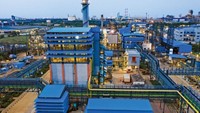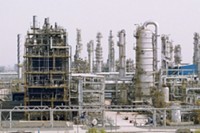Advertisement
Grab your lab coat. Let's get started
Welcome!
Welcome!
Create an account below to get 6 C&EN articles per month, receive newsletters and more - all free.
It seems this is your first time logging in online. Please enter the following information to continue.
As an ACS member you automatically get access to this site. All we need is few more details to create your reading experience.
Not you? Sign in with a different account.
Not you? Sign in with a different account.
ERROR 1
ERROR 1
ERROR 2
ERROR 2
ERROR 2
ERROR 2
ERROR 2
Password and Confirm password must match.
If you have an ACS member number, please enter it here so we can link this account to your membership. (optional)
ERROR 2
ACS values your privacy. By submitting your information, you are gaining access to C&EN and subscribing to our weekly newsletter. We use the information you provide to make your reading experience better, and we will never sell your data to third party members.
Business
Gujarat Is Open For Business
Northwestern state in India attracts disproportionate share of chemical and pharmaceutical industry
by Jean-François Tremblay
July 9, 2012
| A version of this story appeared in
Volume 90, Issue 28

A common story not long ago in the international business press was that smart managers setting up operations in India should head to the south of the country, to the emerging hubs of Bangalore, Chennai, and Hyderabad. Knowledge, know-how, new roads and airports—all of these were in the south. According to this narrative, the infrastructure in northern India was breaking down, politicians were corrupt, and religious rivalries tended to erupt into riots.
GUJARAT AT A GLANCE

◾ State capital: Gandhinagar
◾ Major city: Ahmedabad
◾ Population: 60 million (5% of Indian population)
◾ Value of chemical output: $55 billion (51% of Indian industry)
◾ How to get to Gujarat: A one-hour flight from Mumbai to Ahmedabad; some airlines fly directly to Ahmedabad from Singapore, London, and a few other cities
NOTE: Figures are for 2011. SOURCES: Gujarat Industrial Extension Bureau, Indian Ministry of Chemicals & Fertilizers, OAG Flight Guide
The northwestern state of Gujarat was Exhibit A of all that was wrong in the north. Ten years ago, business confidence in the state dropped to zero after religious violence left hundreds of people dead.
But the state has since rebounded and is now the favorite location for companies setting up manufacturing operations in India. Gujarat has been so successful at putting its house in order that its main obstacle now to attracting even more companies is the inefficiency plaguing the rest of India.
As it is, most of India’s chemical industry, and a large portion of the country’s pharmaceutical industry, is already in Gujarat. There’s lots of opportunity for further Indian chemical industry growth, though. India has about 17% of the world’s people but only 3% of its chemical industry by sales.
These days, when chemical companies look at where they should go in India to take advantage of this growth potential, many choose Gujarat. “India now recognizes that chemicals are key to strong manufacturing,” says Prasad Chandran, the head of BASF in India. “Gujarat is the most advanced state from the chemical industry’s point of view.”
BASF operates several plants in India, the largest one being in Mangalore, in the south. Prospects in India look good for BASF, which supplies chemicals and materials to many industries. “There is a population of youth coming of age,” Chandran says, “and that is leading to a boom in demand for consumer items like cars, beauty products, footwear, and so on.”
The company’s sales in India in recent years have been growing 20% annually, and they now exceed $1.2 billion. This spring, BASF selected a site in Gujarat for a $200 million polyurethane plant that will be comparable in size to the plant in Mangalore. “We want to have two major hubs in India, one in Mangalore to serve the south of the country, and the other in Gujarat to serve the north,” Chandran says.

Recent examples abound of other chemical companies opting to locate their additional Indian operations in Gujarat. They are not always manufacturing plants.
In May, Solvay opened a major R&D center in Savli that will be staffed with 200 people. Solvay already operates manufacturing facilities in Gujarat, but this was not the only reason it located the research center there as well, say Prakash Raman, managing director of Solvay in India. Quality of life, availability of scientific talent, and proximity to customers also played roles. Savli won even when compared with eight other cities, including the major centers of Bangalore, Chennai, Hyderabad, and New Delhi, he says.
Company managers like the predictability of the business climate in Gujarat. “In Gujarat, we can trust that the project announcements made by companies and government agencies will materialize, whereas in the rest of India, we tend to wait and see if anything actually happens,” says Bruce A. Schult, Air Products & Chemicals’ Mumbai-based country manager.
Under the leadership of its chief minister, Narendra D. Modi, Gujarat has implemented numerous changes favorable to chemical and other industries in recent years. Modi is a contentious figure. Many fault him for inciting, or at least not stopping, the religious riots of 2002, which claimed the lives of more than 1,000 people, mostly Muslims.
In February, a court in Gujarat blamed Modi for failing to stop the rampages. Yet, the controversy has not stopped him from implementing numerous policy changes that have benefited economic development in the state.
The riots were traumatizing for Gujarat, says Zerxes F. Lashkari, president of Yezper Consultants, which advises foreign chemical firms on their India market entry. “In the aftermath of the riots, industry in Gujarat was somewhat dead,” he recalls. But a lot has changed since. “Modi has wiped out the corruption, cleaned up the administration, and industry is booming,” he says.
Moreover, Lashkari notes, the state’s chemical industry complies with far higher environmental standards than it did 10 years ago. “Small companies in Gujarat used to pollute the environment like there’s no tomorrow,” he recalls.
Gujarat Alkalies & Chemicals Ltd., a major Indian producer of caustic soda and aluminum chloride based in the petrochemical hub of Vadodara, is one company that is greening its operations. “Our waste site in Vadodara looks like a forest, and our new site in Dahej is home to a bird park,” says M. S. Dagur, the company’s managing director. As a result, he says, there is little friction between the company and farmers living near its facilities. He adds that the company satisfies 16% of its energy needs from a wind farm.
Managers at Gujarat Alkalies credit government support for much of their success over the years. “The government acts as a catalyst for us,” says H. B. Patel, the firm’s chief financial officer. When needed, he adds, the Gujarat government has provided infrastructure essential to the company’s growth.
The government seeks to attract technologically proficient companies from India and abroad, confirms K. T. Vyas, assistant general manager of investment promotion at the Gujarat Industrial Extension Bureau. “We welcome more chemical investments, as long as the companies follow the guidelines of the Central Pollution Board,” he says.
Gujarat goes out of its way to satisfy the needs of the chemical industry, Vyas explains. The state is notoriously dry—both in the prohibition of alcohol sales and in its extended periods of drought. And yet, “the government has never failed to deliver water to the chemical sector, even when it was scarce,” he claims.

The state aims to meet industry’s needs in other ways, Vyas goes on. Being unable to secure an industrial site is a common showstopper in India, but Gujarat makes it easier than elsewhere to secure space, Vyas says.
A recent illustration is the assembly facility for Tata Motors’ Nano, the world’s least expensive car. The plant is now operating in Gujarat because Tata Motors, India’s largest automobile company, was unable to set up on the land it had been granted by the state government in West Bengal, Tata Motors’ initial choice. There, the project faced fierce opposition from farmers protesting that the local government was illegally seizing their land for Tata’s benefit.
The chemical industry comes to Gujarat for reasons besides land, Vyas says. Petrochemical feedstock is provided by refineries in the state, including one of the world’s largest, operated by Reliance Industries in Jamnagar. The state has a 1,000-mile coastline dotted with 42 ports.
Gujarat’s natural gas pipeline network is extensive by Indian standards. And whereas the rest of India is plagued by periodic power shortages, Gujarat has a surplus of power that it sends to other states. In addition, Vyas says, the state is constantly improving its transportation network by turning small roads into expressways and widening existing ones.
Business managers confirm Vyas’ rosy claims. At Inox Air Products, a 50-50 industrial gas joint venture of Air Products and Inox Group, Director Siddharth Jain says Gujarat’s high-quality road network makes the state attractive for setting up gas-bottling operations. “Gujarat is a model for India,” he says. The state is home to local customers for the company’s gases in a variety of industries, he adds.
When Solvay acquired its facility in Panoli in 2006, it took almost five hours to drive there from Vadodara’s airport, recalls India Managing Director Raman. Nowadays, as a result of road improvements, the driving time is just two hours, he says.
Moreover, the Panoli site now gets uninterrupted power from the electric grid, a vast improvement from the scheduled “power holidays” that plagued the area in 2006, Raman adds. Solvay’s main product at Panoli is polyether ether ketone, an engineering plastic known as PEEK. The company exports most of the plant’s output.
In addition to public infrastructure improvements, Gujarat has in recent years set up industrial estates that meet specific corporate needs. The best known of these is probably in Dahej, a 4,200-acre special economic zone, or SEZ, that provides companies tax benefits and access to tailor-made infrastructure for industries as diverse as chemicals and shipbuilding.
The Dahej SEZ offers a “single window” service that simplifies dealings with India’s notorious bureaucracy. It is in Dahej that BASF is setting up its polyurethane plant. “The Indian government foresees that there will be four integrated large-scale chemical industry complexes in India in coming years, and Dahej is the most developed of those sites,” BASF’s Chandran says.
R. J. Shah is chief executive officer of the Dahej SEZ. Shah previously was principal industrial adviser to the Gujarat government. Setting up the Dahej zone, Shah claims, was one of his ideas. “I made policies, and now I am on the implementation side, which is a bit unusual,” he says.
Twelve companies are already operating in the zone, Shah says, even though much of the infrastructure is not yet in place. For instance, the Indian company Torrent Energy is setting up a 1,600-MW power plant. A Japanese consortium is building Asia’s largest water desalination plant to supply both Dahej and the rest of the state. Gujarat State Petronet, a local firm, is setting up a gas pipeline network. The Indian telecommunications firm BSNL is installing a voice and data network. And India’s Oil & Natural Gas Corp. is completing construction of a petrochemical complex that will supply feedstock to downstream chemical producers.
The Dahej package is so attractive that most of the land in the zone has been snatched up by 67 companies. There is room for only 10 more. “We could accept about two or three more chemical makers, but we cannot expand further,” Shah warns.
The high interest in a location like Dahej illustrates India’s shortage of sites suitable for companies in the chemical and other industries with unique infrastructure needs. Seeing an opportunity, private Indian companies in Gujarat and elsewhere have come forward with plans to set up privately managed industrial parks offering services similar to those in Dahej.
One such plan comes from Cadila Pharmaceuticals, a producer of generic drugs with headquarters in Ahmedabad. The company hopes to set up a 420-acre industrial estate at Dholera, near where Ahmedabad’s second international airport is being built. Cadila’s project will focus exclusively on the pharmaceutical industry.
Cadila itself hopes to occupy 10–15% of the land in the park, which will enjoy certain tax advantages. “We’re not doing this for ourselves; there will be room for other companies,” promises Indravadan A. Modi, the company’s founder and chairman. But Cadila is expanding, he points out, partly by developing innovative cancer drugs and vaccines. Three drugs are in clinical trials and could be launched soon, he claims.
Although construction of the park has not even begun, Abhinand Pandya, a company official who promotes the project, points out that the venture has obtained a “comprehensive” clearance, which is a significant step in the Indian regulatory process. Cadila is now recruiting partners to provide services such as water, steam, gas, and waste treatment. Cadila’s model for the zone is not the Dahej SEZ, Pandya says, but rather Singapore’s Jurong Industrial Estate, which he calls one of the world’s most desirable investment locations.
The steady improvement of infrastructure in Gujarat and the level of support the government lavishes on industry go a long way to explain why the state is India’s most desirable location for the chemical industry. But compared with other locations around the world, Gujarat still has much room for improvement. The biggest problem is that the rest of India is not on the same page as Gujarat when it comes to creating a business-friendly environment.
Advertisement
For several years, Joerg Strassburger, Lanxess’ managing director in India, has been a critic of India’s shortcomings as an investment location. Gujarat is certainly more attractive than other Indian states, he says, but that has not been enough to convince Lanxess to commit to capital expenditures in India that are proportional to the country’s size.
Whereas Lanxess has invested $90 million at its site in Jhagadia, it is spending $250 million in Singapore to build a polybutadiene rubber plant, Strassburger points out. “One of the major reasons is that the materials we require are available in Singapore, and in India they are not,” he says. “The markets are in China and India, but raw materials are a critical thing.”
In Gujarat, as in the rest of India, many materials are available from a single supplier that holds a monopoly, Strassburger says. Gujarat could take steps to improve the availability of raw materials, he adds, but it must overcome other shortcomings as well.
For instance, Lanxess’ Jhagadia facility exports about 80% of the ion-exchange resins it produces. It would be most convenient to ship from one of Gujarat’s many ports, but ship departures are too infrequent at the moment, Strassburger says. Instead, Lanxess sends the resins by road to Mumbai, where they can be loaded onto ships more quickly.
But road transportation in India is also a problem, Strassburger adds. Gujarat may be making great progress in improving its road network, but other states are not. “The costs of transporting goods throughout India are the same, even if you’re in Gujarat,” he points out.
It is becoming increasingly clear that Gujarat needs change at the national level to make itself more attractive as an investment destination. For the chemical industry, change may be under way in the form of a draft national chemical policy now under review at the Ministry of Chemicals & Fertilizers.
“This policy addresses the need to set up integrated chemical industry clusters, R&D, sustainability, people development, feedstock, and so on,” says BASF’s Chandran, who is part of the committee that drafted the policy. “It’s very comprehensive.”
The draft policy is making progress toward implementation, Chandran maintains, but Strassburger is skeptical. “The draft addresses the right points, but will it be implemented, and how long will it take?” he asks. “At this point, I don’t see any activity.”
Even Strassburger would agree that, in a mere 10 years, Gujarat has made great strides in transforming itself from a pariah to one of India’s most desirable business destinations. But it’s clear that the state needs help from the rest of India if it is to become a truly world-class investment destination.





Join the conversation
Contact the reporter
Submit a Letter to the Editor for publication
Engage with us on Twitter